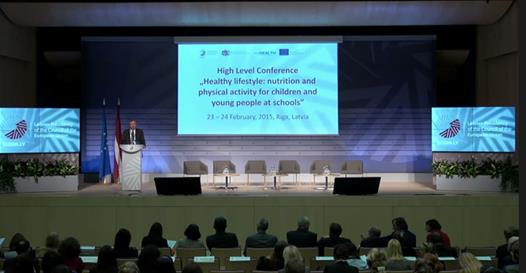Europe’s Judgement Day came on Monday, when Member State representatives, international health officials and medical experts met at The High Level Conference on Healthy Lifestyles held to discuss the state of childhood obesity in Europe. Are our children’s waistlines getting larger? Are existing initiatives helping us get healthy? What more do we need to do?
As in all conferences, papers and discussions about obesity, no clear cut answers were provided. While International Organization such as the WHO, OECD and EU Commission pointed to overwhelming amounts of data indicating the gravity of the obesity pandemic, Member States provided a number of enlightening examples of good practice, both at national and local level.
So how well are we actually doing?
The Commission and World Health Organization were fairly fatalistic.
John F. Ryan, a veteran of EU health policy and Director of the Public Health division at DGSANTE, noted that chronic diseases are responsible for 80% of deaths in Europe, hampering social cohesion and economic growth, despite being easily preventable. He called on the food and drink industry, NGOs, governments, parents and schools to help reduce childhood obesity by ensuring access to balanced and healthy meals and helping children engage in regular physical activity.
Dr Gauden Galea (Director of the Division of Noncommunicable Diseases of the WHO) used similar language to explain the importance of creating healthy food and drink environments in schools, as well as incorporating more physical activity in the curricula and funding infrastructure for this to occur.
But is it all doom and gloom?
Member states portrayed the situation in a more positive light. Latvia, Estonia and Hungary presented their own projects to ensure free, healthy meals in schools. The common denominator was the setting of national standards which list a number of allowed or required products in school meals such as fruit and vegetables, while excluding all confectionary and sugary or fatty foods. Under regulation 610, the government of Latvia also restricted the marketing and distribution of salty snacks and sugary drinks in schools – bringing a 10% reduction in consumption. For more examples on the Estonian and Hungarian models, you can watch the presentations here.
And how significant are these initiatives?
The national food schemes presented at the conference seemed extremely similar to the prescriptions laid out in the WHO European Food and Nutrition Action Plan launched in 2014, which demands 4 (or in truth, 5) key policy changes:
- Implementing mandatory standards for school meals
- Providing nutritional education in schools
- Offering free fruit and vegetable schemes
- Imposing strong controls on the marketing of food and non-alcoholic beverages in schools
- …as well as adopting initiative for physical activity.
Yet international organizations were all but satisfied. Dr Joao Breda of the WHO – who was defined throughout the conference as the guru on obesity policy – pointed to the strong disparity among schools even within single countries to conclude that more work needs to be done on the process of implementation – as also argued by Mr. Goof Buijs of the Schools for Health in Europe Network.
So if member states got a scolding, how did industry perform? It’s not looking good…
Although Stephan Loerke from the World Federation of Advertisers made a convincing argument to illustrate the value of industry efforts, it seems that there is a lack of trust in industry self-regulation among international organizations, and that industry commitments are deemed insufficient.
Stephan illustrated the efforts made under the European Platform for Action Diet, Physical Activity and Health to showcase industry’s proactive involvement. He reasoned that while the direct effect of marketing on children is only “modest”, as noted in most scientific literature, the food industry has recognized that marketing impacts family food choices, preferences and behaviours, and has therefore acted accordingly. Stephan mentioned the new initiative of the International Food and Beverage Alliance, due to come into force in 2016, which imposes thresholds for all marketing platforms, creates a single nutritional model to be used among all countries and bans the use of celebrity personalities.
In a final attempt at convincing his medical public, he decried the low levels of recognition for industry self-regulation… and he was certainly correct.
His most ardent critic was Tim Lobstein of the World Obesity Federation, who diplomatically defined the EU Pledge as not strong enough… to avoid using the term ‘useless’. He noted that, on marketing commitments, the 35% threshold of children watching television (which is necessary to prevent food promotion under the pledge) is very rarely reached. In addition, advergames such as on Nestle’s website are not included in the provision.
Even new developments were easily discarded. Lobstein mentioned that the new nutrient profiling system is still too lenient, especially on the threshold for salty snacks, such as crisps, and sugary products, including cereals. The WHO had other concerns, questioning whether third party auditing is reliable, with Joao Breda suggesting that the scientific community should be integrated in the monitoring of the commitments. He also called for the recently released WHO nutritional criteria for marketing to children to be taken into consideration.
Unfortunately, it seems that International Organizations will remain forever skeptical.
When asked what the biggest obstacle to an effective, coherent policy on obesity is today, Joao Breda pointed the finger at industry, saying that their influence on policy makers is to blame for the lack of effective policy measures being taken… a fairly simplistic answer for a guru, in this blogger’s opinion.
Nonetheless, the Commission was kinder in its approach. Philippe Roux, the head of Unit for Health Determinants at DGSANTE even praised the work of the EU Platform, noting that the commitments made under the EU Pledge (and specifically the responsible advertising measure which classifies schools as protected environments) have made an important difference.
Mr Artur Furtado from DGSANCO also adopted a more balanced position, taking into account the role of government structures in preventing effective policy measures. He claimed that changing representations prevent long term plans from being made and that government systems which separate policy provisions on health from agriculture and education inhibit the development of integrated and holistic solutions. His resounding message: there needs to be greater policy cohesion.
Since we’ve done pretty poorly, what’s next?
In line with the more market-oriented objectives of the new Commission, future work on healthy lifestyles will be aimed at abating health inequalities. The Commissioner has asked the private sector to do more on reformulation in the context of the EU Platform. Better mapping of Member State capabilities and resources to tackle obesity and endorse preventative measures also made the top of the to-do list.
However, the real shift in obesity policy will be a global move to a more comprehensive approach that takes into account the social and economic context of obesity prevention. Prescriptive approaches to obesity no longer make the cut. Providing information in terms of labelling is not a determinant to health in the same way that engaging in physical activity is not a determinant of active lifestyles.
Taking a more holistic approach which encompasses an understanding of how information shapes behavioral choices and how urban environments influence our levels of physical activity, will be crucial to tackling this problem of the modern age – a system has been defined as health in all policies.
Find Out More
-
Generative AI is changing the search game
May 8, 2025
-
The challenges facing Europe and European leaders at Davos 2025
January 24, 2025




